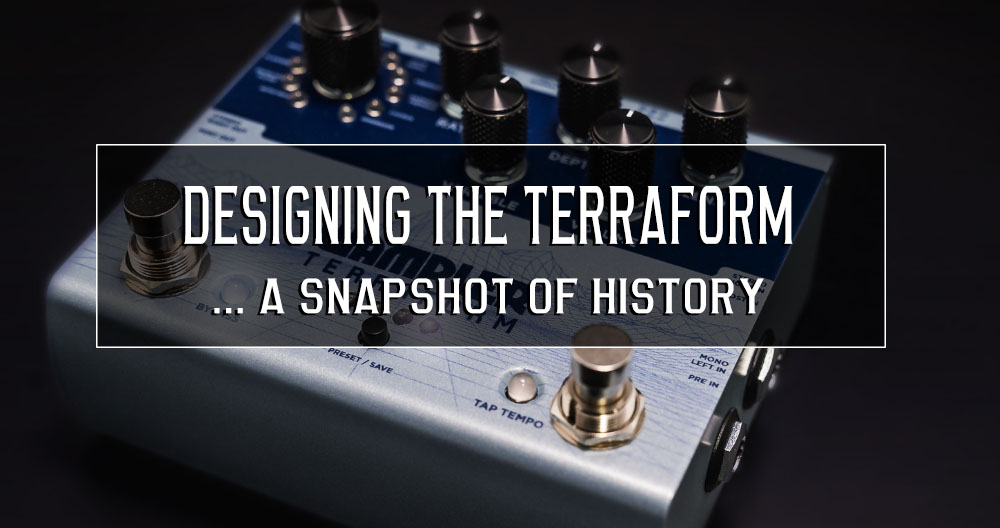
I honestly can’t remember how long we’ve been working on this pedal… If I’m going to have an educated guess, I’d say it’s been well over a year – probably about 18 months. It all started in a meeting we were having, Alex was saying (as usual) “What are we going to do next?” when Brian said, in an offhand way, “I want to do a multi modulation pedal, full stereo”. This of course, as the proud owner of a Helix; Strymon Mobius and BOSS MD-500, was a statement that filled me with both abject horror and fascinated delight. You see, I’ve been wanting to go into this side of things for the longest time, but we haven’t really had the capability to do it.
With chief Wampler engineer, Jake Steffes, now neck deep in the style of programming that would require the realisation of this kind of unit, we were primed and ready to go. Brian’s main thing was stereo, mine was live use. As most people still run a mono rig for live, I was instantly thinking about everything we needed to make sure the pedal could not only be a stereo delight, but also something that those with a midi controller could use to get the most out of it. Also taking into consideration those that don’t have a looper – especially those who are basically terrified of midi.
Fortunately for us, 3 of the people who are mostly involved in the design and realisation of bringing pedals to market bring 3 very distinct perspectives to the use of pedals, and not one of us is afraid to fight to the death to get what we want. At this moment, I would like you all to pause and remember, fondly and with deep reverence, Jake’s sanity, as he is the one who had to wade through our endless back and forth and decipher what was practical for a pedal. These days, the vast majority of Brian’s playing is done in his studio, so he is usually looking at things from a recording perspective. I’m a perpetual gigger, so everything is about live use and Alex doesn’t really do either these days (due to work and family commitments) so he’s looking from the perspective of the terminal tone chaser who plays at home and is all about how easy it is to use.
OK, so that is where it all started. When we first had a meeting to discuss the “Wampler MultiMod project” Brian laid out a few things that he deemed essential and, as it’s his name on the pedal, the things we simply could not argue (which kills me, as I love to argue). “The effects have to be as good as we can make them. It has to be small. It can’t be stupidly expensive and it needs an expression pedal…”. My input was “Routing is essential, so I want to allocate some blocks pre and others post gain, if we are having presets I want midi control and the interface has to be really easy to use” and Alex, always the voice of reason was saying “It has to be able to be more plug and play than anything else, so no hidden controls”.
Part of my job in the design process is laying out the front panel and jacks etc… we had quickly decided that we didn’t want an LED screen on it, or any kind of screen in fact, so the control selector had to have LED’s round it. We saw that we needed 4 parameter controls with a switch, dual ins and outs, midi in and out, exp control, power etc.
The initial phase of design is always the layout, basic feature set, control features, size, etc etc… Brian was VERY keen to have it as small as possible, so Jake and I spent a long time battling over everything, I was adamant it needed to have top jacks, but it literally couldn’t. However, as a form of compromise, with it having the side jacks it meant we could put an extra knob from where we originally were and the unit could actually be slightly smaller than we originally thought it could be – so, it was a win on many fronts.
As we headed into Winter NAMM 2019, we literally threw in the algorithms Jake had already designed, manufacturing made a new box design for it that was amazing, Richard Oliver and I worked on the graphical stuff and away it went…
Fortunately, for us, “NAMM” collectively loved it.
Once we had returned from NAMM, we discretely analysed everything the people who had played it had said to us, not so discretely asked our customers what they wanted in a multi mod pedal and went about making it perfect. At NAMM, Brian had said he was hoping for an April release, but in the days that followed NAMM it was obvious we were running up a hill so we decided that we could either get something out at that time, or just keep plugging away at it until we were all happy it was as good as we could get it.
The following months saw Jake working all the hours under the sun (and a lot of those under the moon) working out how to make what we wanted a reality. During this time, we spoke to everyone we knew about modulation tones, pedals, effects etc to get as much information as possible. Travis was a regular visitor to the barn to try out various versions, it got to the point where I swear Dan from TPS was going to block my number as I was forever ringing him and texting him with questions like “What’s your favourite Mistress style Flanger” or “Midi, we are currently here, what else do we need” and so on and so forth. Over the following 10 months Jake produced about 250 versions of the 11 effects we have now.
This is how we go about designing the algorithms… Jake designs the algorithms and sends them to us as Logic Plug-Ins. Not only do they have the 5 main controls in the plug in but, at times, up to 20 variables for the effect that we have to nail down and agree on to make the them sound like we want them to. This is where the genius of Brian Wampler is evident… for example, when I’m forging a tone in say, the Flanger and I’m setting the positioning of waves, timings and other stuff, he literally receives my version and sends it back 5 minutes later with the tiniest of tweaks that make the biggest difference. These are not the kind of tweaks a normal mortal human can make, only those with the hearing of a deer.
I think it was around the time of Summer NAMM that we were about 75% complete on the algorithms. Collectively we weren’t happy with the Flanger, the Phaser and the Envelope Filter, but we were, at that time, concentrating massively on the user interface and how we could improve it, make it the best it could be. It was usually Jake and myself doing this, we tried to think of everything and I think we did. Over the space of those 10 months we went from a stereo/mono pedal, with some monos blocks being allocated pre and post gain; midi patch changes with some exp control, to full stereo with certain effects spreading out the full 180 degrees of the field, and some at 90, pre/post allocation on a global level and via individual patch level, expression pedal levelled up to being able to control ANY of the five controls (with the user being able to define the toe and heel point) from straight up midi recollection of patches to full midi mapping and tap tempo control, 8 presets instead of 4, presets being controlled via the button to include midi mapping and from the stomps, and most importantly, all the way up to the five controls are used to make the user experience the best it can be…. And breathe…
In the 11th hour, so to speak, Jake revisited the Flanger/Phaser and Envelope Filter and re-presented them to us and they blew us away, the pedal was complete. All we now had to do was redesign all the packaging and, both style of manuals… We normally have a small inbox manual and a two page online one, we ended up with a fully graphical inbox manual and a 20 page online one.
We sincerely hope you enjoy the Terraform, it’s safe to say it’s been the pedal that has the most amount of our blood, sweat and tears in!
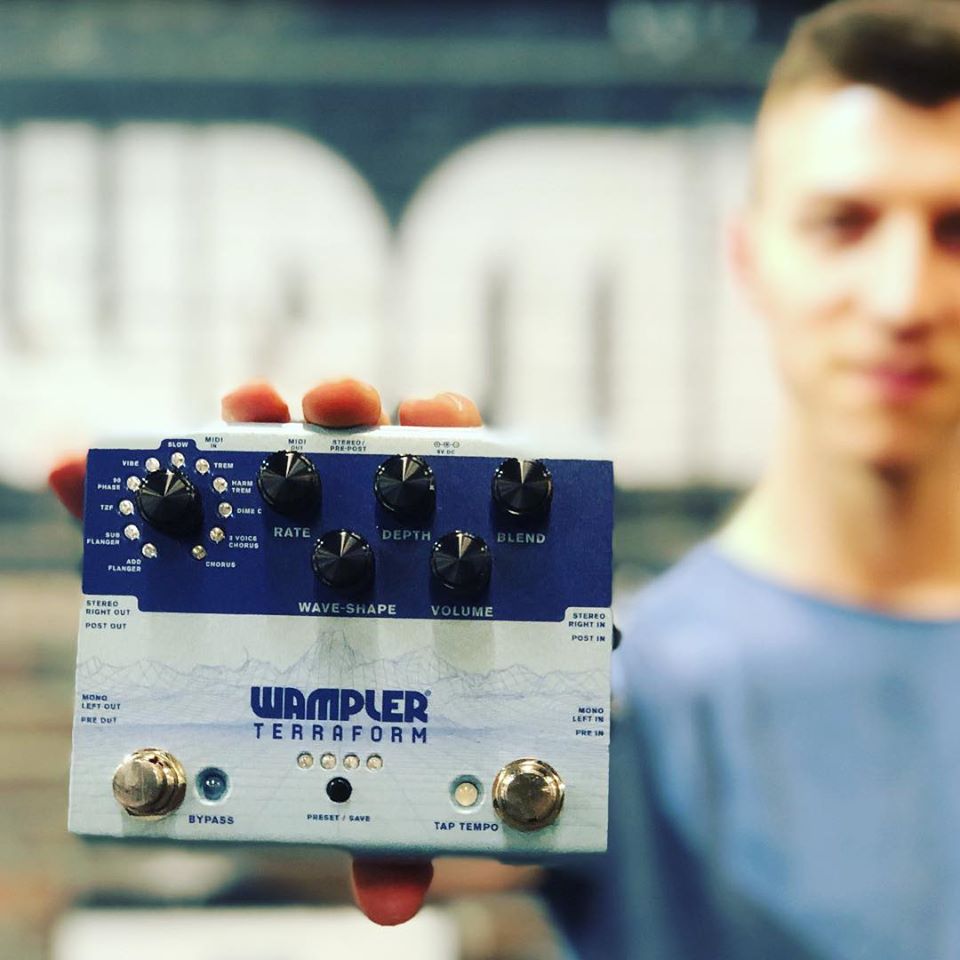
Jake Steffes holding up the proto of the Terraform, January 2019.
Check out Tom Quayle’s extensive demo of the Terraform…
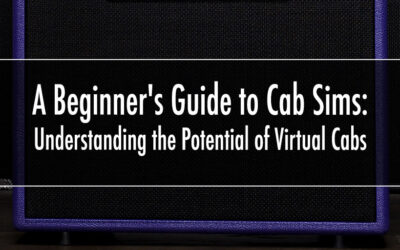
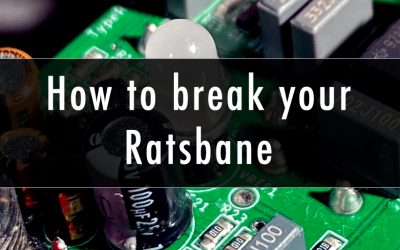
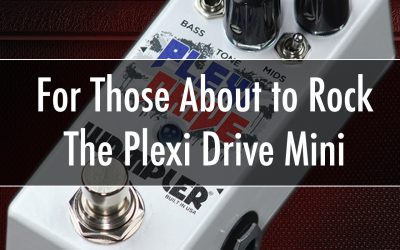
The bottom video is JLeonardJay and not Tom Quayle. I have also seen Tom’s video, which was part of the reason I purchased the Terraform. It does everything I’ve wanted in a reasonably priced, smallish multi-modulation pedal.
I ordered the Terraform from Sweetwater before it was released. I’ve had it for a while now…time flies when you’re having fun. All the effects are top of the class, best I’ve ever heard. Killer Uni-Vibe!!! There’s only one thing that seems a little incongruous to me. The pedal does 11 effects but only 8 presets that I can call up from MIDI. So I’ve got to pick and program my favorite 8 or less if I want multiple options. I’m also an engineer, so I’m guessing that 8 was all that memory would handle and any more would require additional memory and additional cost and size. How about making all the parameters MIDI programable in a future version?
I’ve had my Terraform for a few months now and totally love it. It’s on my small board now and does the job of 4 pedals on my big board with so many more options. Now I’m spoiled and hope you develop a similar pedal for delay/reverb with tape, echorec, reverse, shimmer, plate, hall, memory, exp, and well you get the idea. I already have a few delay and reverb pedals but I know yours would be killer. Thanks for the inspiration.